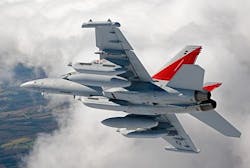Navy chooses Raytheon to build Next-Generation Jammer (NGJ) for EA-18G and other aircraft
PATUXENT RIVER NAS, Md., 10 July 2013. U.S. Navy aviation leaders are choosing the Raytheon Co. Space and Airborne Systems segment in McKinney, Texas, to build the Next Generation Jammer (NGJ) to enable the EA-18G Growler carrier-based jet to jam enemy radar, communications, and other RF systems.
Officials of the Naval Air Systems Command at Patuxent River Naval Air Station, Md., announced a $279.4 million contract to Raytheon Monday for the technology development phase of the NGJ program to replace the legacy ALQ-99 tactical jamming system on the Growler aircraft.
Eventually the NGJ program may expand to include an add-on electronic warfare (EW) jammer for the F-35 Raptor joint strike fighter that would not require a specially made EW aircraft like the EA-18 Growler.
The Navy's selection of Raytheon to build the Next-Generation Jammer ends a long competition for the program that pitted Raytheon against competitors ITT Exelis/Boeing, Northrop Grumman, and BAE Systems.
Raytheon’s NGJ will provide airborne electronic attack and jamming capabilities, and will include cyber-attack capabilities that use the aircraft's active electronically scanned array (AESA) radar to insert tailored data streams into enemy systems.
The Raytheon NGJ will integrate advanced electronic attack technology into the EA-18G with a combination of high-powered, agile beam-jamming techniques, and solid-state electronics. The Raytheon NGJ also will have an open-systems architecture for future upgrades.
Eventually the NGJ may be fitted to unmanned aerial vehicles (UAVs) in addition to the EA-18G and F-35, as well as to other manned aircraft. Raytheon will use its gallium nitride (GaN)-based AESA technologies for the NGJ design.
The goal of the NGJ technology-development phase is to develop an electronic attack system that will improve airborne electronic attack capabilities against advanced threats through enhanced agility and precision within jamming assignments, increased interoperability, and expanded broadband capability for greater threat coverage against a wide variety of radio frequency emitters, Navy officials say.
On the NGJ contract Raytheon will do the work in El Segundo, Calif.; Fort Wayne, Ind.; Dallas; Torrance, Calif.; Clearfield, Utah; McKinney, Texas; Tucson, Ariz.; Marion, Va.; Goleta, Calif.; Forest, Miss.; and Andover, Mass., and should be finished by May 2015.
For more information contact Raytheon Space and Airborne Systems online at www.raytheon.com/capabilities/ew, or Naval Air Systems Command at www.navair.navy.mil.
